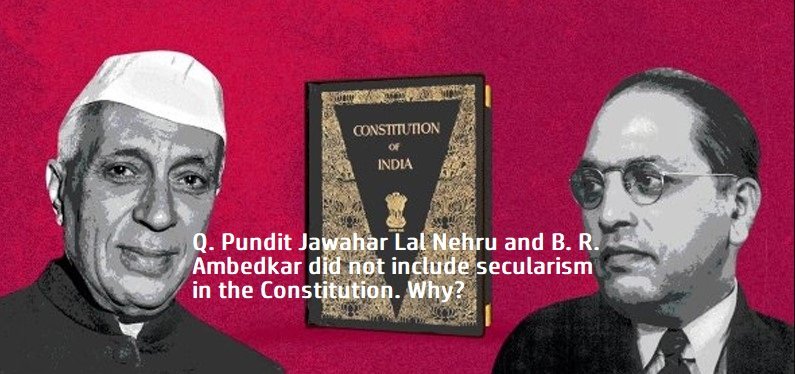AWIP, Indian Polity & The Constitution of India
Q. Pundit Jawahar Lal Nehru and B. R. Ambedkar did not include secularism in the Constitution. Why?
The absence of an explicit mention of “secularism” in the original Constitution of India can be attributed to several historical, political, and ideological factors involving key figures like Jawaharlal Nehru and B.R. Ambedkar. Here are some of the reasons why secularism was not included explicitly:
1. Historical Context:
- During the framing of the Constitution in the late 1940s, India was emerging from the colonial rule of the British and grappling with the challenges of partition. The focus was on national unity and integration rather than explicitly defining secularism as a constitutional principle.
- The communal tensions and violence during the partition influenced the framers to prioritize stability and the protection of minority rights rather than explicitly enshrining secularism.
2. Constitutional Philosophy:
- Jawaharlal Nehru and other leaders believed in a pluralistic society where multiple religions could coexist. They felt that emphasizing secularism might alienate religious communities or cause conflict rather than foster unity.
- The Constitution included provisions for fundamental rights and minority rights, which were seen as sufficient guarantees to protect religious freedoms without the need for explicit secularism.
3. Ambedkar’s Perspective:
- B.R. Ambedkar, the chief architect of the Constitution, had a nuanced view on religion and politics. He advocated for the rights of Dalits and other marginalized communities, focusing on social justice rather than a strict secular framework.
- Ambedkar was concerned about the caste system and its intersection with religion. His focus was more on ensuring equality and social justice, which he believed would naturally lead to a secular state.
4. Existing Provisions:
- The original Constitution contained various provisions that reflected a secular ethos, such as:
- Fundamental Rights: Articles that ensured freedom of religion, protection of minority rights, and equality before the law.
- Article 15: Prohibited discrimination on grounds of religion, race, caste, sex, or place of birth.
- Article 25: Guaranteed the freedom of conscience and the right to freely profess, practice, and propagate religion.
5. Political Considerations:
- The political climate of the time necessitated a careful approach to religion and politics. The framers were aware of the delicate balance required in a diverse society and preferred to avoid contentious issues that could lead to further division.
- Nehru was particularly focused on nation-building and promoting a modern, scientific outlook, which he felt could be achieved without explicitly stating secularism.
6. Cultural and Religious Dynamics:
- The Indian society was (and remains) deeply influenced by religious and cultural identities. The framers aimed to recognize this reality by including provisions that would respect and protect these identities rather than imposing a rigid secular framework.
Later Developments:
While secularism was not explicitly stated in the original Constitution, it was eventually recognized through various amendments and judicial interpretations. The 42nd Amendment in 1976 added the word “secular” to the Preamble, solidifying India’s commitment to secularism as a fundamental principle of the state.
Conclusion:
The decision not to explicitly include secularism in the Constitution by leaders like Nehru and Ambedkar was influenced by a combination of historical context, political considerations, and a focus on unity and social justice. Despite its absence in the original text, the values of secularism have been upheld and reinforced through subsequent amendments and judicial rulings, reflecting the evolving nature of India’s constitutional framework.


